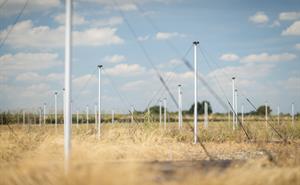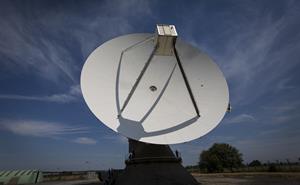The Daresbury Laboratory was established in 1962 in Cheshire and the Rutherford High Energy Laboratory (now the Rutherford Appleton Laboratory) was set up in 1957 in Oxfordshire, both of which later became part of the Science and Technology Facilities Council. And in 1967, nestled in the heart of rural Hampshire, a little piece of the space race was opening its doors.
Radio astronomy and atmospheric sciences
The Chilbolton Observatory was established to support cutting edge radio science activities. The fully steerable antenna erected there between the years 1964 and 1967 had a 25m diameter reflector with unparalleled surface precision and was sensitive enough to detect faint signals from radio stars at high frequencies not done before in the UK and led pioneering radio astronomy research.
After the opening of the site on 14th April 1967, the Observatory support an increasing number of experiments with the addition of further scientific capabilities, including radar and lidar instruments along with other sensors for precision meteorological observations. The work supports atmospheric science for the National Centre for Atmospheric Science. The site is also home to LOFAR-UK, the UK station of the Europe-wide Low Frequency Array radio telescope.
Chilbolton will host an optical ground station which, with the RAL Space built Speqtre spacecraft and existing satellite communication antennas will demonstrate that quantum encrypted communications links can be conducted over globe spanning distances via satellite.

Image: LOFAR telescope array at Chilbolton. Credit: Theo Moye.
The 25m dish
The iconic 25m dish is still operational, but no longer doing radio astronomy. Its antenna can be pointed at any location in the sky, and at speeds which mean it can track not only slow-moving stars, but also rapid satellites in orbit. This mechanism still works, 55 years on and is operating productively as the world's largest fully steerable weather radar, feeding data into weather models and to research by atmospheric scientists.
This capability is also being used to detect and track satellites and space debris for UK Space Agency and propagation studies for the European Space Agency and the Defence Science and Technology Laboratory. This work is helping shed light on a problem that hadn't been dreamed about when the dish was built, just ten years after the world's first artificial satellite was launched. satellite tracking

Image: 25m antenna today at the Chilbolton Observatory. Credit: STFC RAL Space.
The dish is a prominent local landmark but remains relatively unsung beyond the research community. However it achieved 5 minutes of fame when it featured in Apple TV's Invasion series in 2020, although the rolling Hampshire hills had to be disguised as Japanese countryside (see the trailer – blink and you'll miss it!).
The observatory remains a hub for science and innovation, staffed by a small but dedicated team who keep the observatory running, undertake research and enable UK and international scientists to access this important national asset.
Find out more
Chilbolton Observatory
Building the 25m antenna
